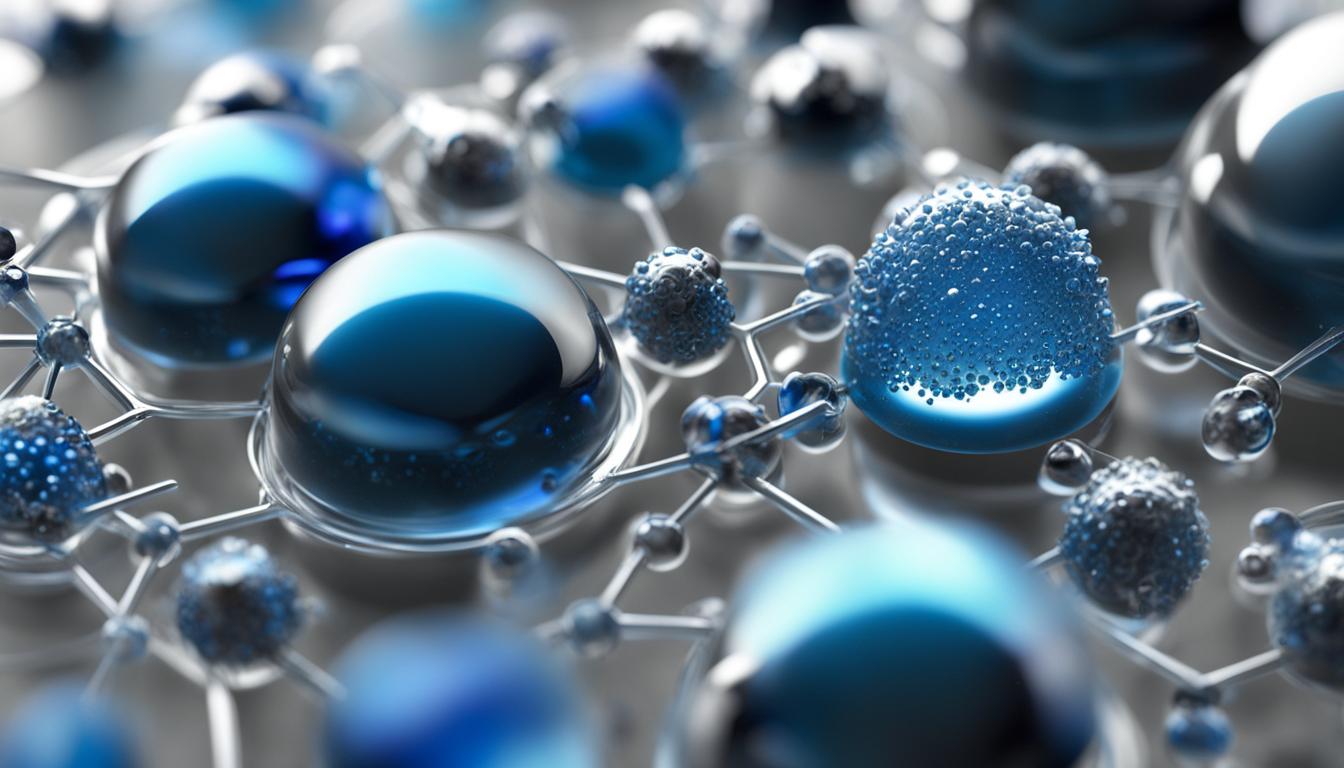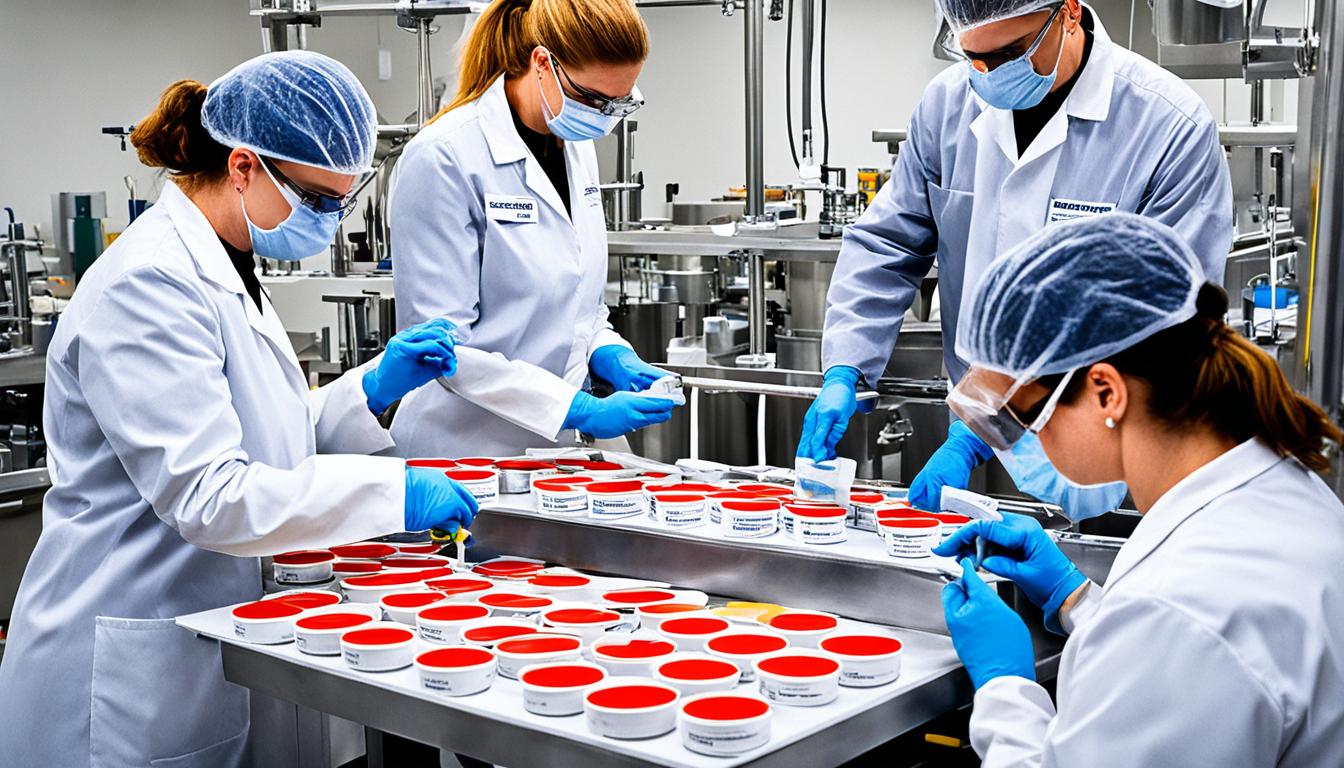
The Role of Nanotechnology in Enhancing Hydrocolloid Functions
SUBSCRIBE TO OUR BLOG
Promotions, new products, and recipes.
Hydrocolloids are essential ingredients in various industries, including food, pharmaceuticals, and cosmetics. They are used as thickeners, stabilizers, and emulsifiers, among other functions. Nanotechnology has emerged as a promising tool for enhancing the properties and applications of hydrocolloids.
Nanotechnology involves the manipulation of materials at the nanoscale, which is 1 to 100 nanometers. By leveraging this technology, researchers can create materials with improved functionality and performance. In the case of hydrocolloids, nanotechnology enables the development of materials with enhanced stability, texture, and functionality.
Key Takeaways:
- Hydrocolloids are essential ingredients in various industries, including food, pharmaceuticals, and cosmetics.
- Nanotechnology has emerged as a promising tool for enhancing the properties and applications of hydrocolloids.
- Nanotechnology involves the manipulation of materials at the nanoscale, which is 1 to 100 nanometers.
- By leveraging nanotechnology, researchers can create materials with improved functionality and performance.
- Nanotechnology enables the development of hydrocolloid materials with enhanced stability, texture, and functionality.
Understanding Hydrocolloids and Their Benefits
Hydrocolloids are a group of long-chain polymers that have the ability to form gels and viscous solutions when they come into contact with water. They are commonly used in various industries, such as food, pharmaceuticals, and cosmetics, for their unique properties and benefits.
One of the primary benefits of hydrocolloids is their ability to improve the texture and mouthfeel of food products. They can be used as thickeners, stabilizers, and emulsifiers in a wide variety of foods, including dairy products, dressings, sauces, and baked goods.
Hydrocolloids also offer benefits in the pharmaceutical industry, where they can be used as drug delivery systems. They can help to control the release of drugs over time, ensuring a more consistent and effective dosage.
In the cosmetic industry, hydrocolloids are used as thickeners and stabilizers in various products, such as lotions and creams. They can help to improve the texture and consistency of these products, making them more effective and appealing to consumers.
Overall, the benefits of hydrocolloids are vast and varied, making them an important component in many products across various industries.
"Hydrocolloids offer benefits in the pharmaceutical industry, where they can be used as drug delivery systems."
Nanotechnology in Hydrocolloids
Nanotechnology has revolutionized the field of hydrocolloids by offering new methods to improve the properties and functionalities of hydrocolloid materials. The integration of nanomaterials has resulted in hydrocolloid products with enhanced stability, texture, and overall performance.
One of the primary benefits of nanotechnology in hydrocolloids is the ability to engineer hydrocolloid materials at the nanoscale. This allows for precise control over the properties of the hydrocolloid material and the development of specific functionalities for various applications. By manipulating particle size and structure, nanotechnology provides a new window of opportunity to optimize hydrocolloid properties and performance.
Nanomaterials in Hydrocolloids
The integration of nanomaterials into hydrocolloids has led to new possibilities in terms of stability and functionality. The use of nanoparticles allows for improved barrier properties, which can be particularly useful in food packaging. In addition, the incorporation of nanomaterials can result in hydrocolloid products with enhanced sensory attributes, such as improved texture and appearance.
| Nanomaterials | Functionality Enhanced |
|---|---|
| Nanocellulose | Improves viscosity |
| Nanoparticles | Enhances barrier properties |
| Nanocapsules | Controlled release of active ingredients |
The integration of nanomaterials in hydrocolloids has also resulted in the development of new hydrocolloid-based systems for drug delivery. The use of nanomaterials allows for the controlled release of active ingredients, increasing the efficacy of the drug and reducing potential side effects.
The Future of Nanotechnology in Hydrocolloids
As with any emerging technology, there are still challenges to overcome and opportunities to explore regarding nanotechnology in hydrocolloids. Safety concerns regarding the use of nanomaterials have yet to be fully addressed, and regulatory guidelines for the application of nanotechnology in hydrocolloids are still in the works.
However, the potential benefits of nanotechnology in hydrocolloids are vast, and further advancements in the field are expected. Researchers continue to explore new ways to optimize hydrocolloid properties through the integration of nanomaterials and the development of new formulations and processes.
The future of nanotechnology in hydrocolloids looks promising, with potential applications ranging from food additives to drug delivery systems. By harnessing the power of nanotechnology, hydrocolloids can continue to be optimized for a wide range of uses and industries, leading to the development of new and innovative products.
The Advancements in Hydrocolloid Technology
Hydrocolloid technology has come a long way since its inception. With the advent of modern processing techniques and new formulations, hydrocolloids have become an essential ingredient in various industries. From food to pharmaceuticals and cosmetics, hydrocolloids offer a range of benefits that make them an indispensable component in many applications.
One of the significant advancements in hydrocolloid technology is the development of new formulations. Manufacturers are continually exploring new combinations of ingredients that can optimize the properties of hydrocolloids, such as stability and solubility. These new formulations have led to more versatile and effective hydrocolloid products that can meet the specific needs of different applications.
The process of hydrocolloid production has also benefited from technological advancements. Modern processing techniques have made it possible to produce hydrocolloids with higher purity and consistency. This has resulted in improved performance and reliability in various applications, such as in pharmaceuticals and cosmetics.
Another significant advancement in hydrocolloid technology is the use of new processing methods. The introduction of nanotechnology has allowed for the creation of hydrocolloids with unprecedented properties, such as enhanced stability, improved texture, and controlled release mechanisms.
The application of nanotechnology to hydrocolloid technology has also opened up new avenues for hydrocolloid uses. In the food industry, for example, the use of nanomaterials has led to new formulations of hydrocolloids that can improve the texture, shelf life, and sensory attributes of food products.
Overall, hydrocolloid technology has evolved significantly in recent years, thanks to the development of new formulations, processing techniques, and the application of nanotechnology. These advancements have led to more efficient and effective hydrocolloid products that have a wide range of uses in various industries.
Nanotechnology Engineering in Hydrocolloid Development
Nanotechnology has opened up an array of possibilities for engineers to design and optimize hydrocolloid materials for specific applications. The use of nanotechnology in hydrocolloid development has created groundbreaking opportunities for the food, pharmaceutical, and cosmetic industries, among others.
Nanotechnology engineering aims to modify hydrocolloid properties by utilizing commercially available nanomaterials. These nanomaterials are synthesized to have unique properties that can improve the behavior of hydrocolloid materials.
Nanomaterials used in Hydrocolloids
Various types of nanomaterials are used in hydrocolloid development to enhance their properties. These include:
| Nanomaterials | Properties |
|---|---|
| Nanoparticles | Improve texture and stability |
| Nanocapsules | Controlled release systems for drugs or flavors |
| Nanofibers | Improve transparency and mechanical properties |
| Nanoporous materials | Enhance adsorption and catalytic properties |
Applications of Nanotechnology Engineering in Hydrocolloids
The use of nanotechnology engineering has led to the development of hydrocolloid materials with improved properties. Some applications of nanotechnology engineering in hydrocolloid development include:
- Drug delivery systems
- Controlled release systems
- Biodegradable packaging materials
- Improved food additives
The use of nanotechnology in hydrocolloid development has also opened up avenues for environmental sustainability. Nanomaterials can be used to produce biodegradable, eco-friendly hydrocolloid materials that reduce waste and improve energy efficiency.
In conclusion, nanotechnology engineering has brought significant advancements in hydrocolloid development. By utilizing nanomaterials, engineers can design and optimize hydrocolloid materials for specific applications, leading to the development of improved products with enhanced properties.
Applications of Nanotechnology in Food Hydrocolloids
Food hydrocolloids are widely used as additives to improve texture, stability, and shelf life in various food products. Nanotechnology has enabled significant advances in food hydrocolloids, providing innovative solutions to current challenges in the food industry.
The use of nanotechnology in food additives has revolutionized the industry, as it allows for improved control over nanostructures, resulting in enhanced properties and functionalities. For instance, the incorporation of nanoscale particles, such as cellulose nanocrystals, can improve the mechanical strength and thermal stability of hydrocolloid-based systems.
Moreover, nanotechnology can enhance the sensory attributes of food products by modifying their texture, flavor, and appearance. Nanoparticles can significantly influence the rheological properties of hydrocolloid-based systems, modifying their flow behavior, and improving their mouthfeel.
Another promising application of nanotechnology in food hydrocolloids is the development of nanosensors for food quality and safety monitoring. By integrating nanoscale materials into hydrocolloid formulations, it is possible to create biosensors that can detect and quantify specific food contaminants or pathogens.
Overall, nanotechnology is a crucial tool in the development of new and innovative food products with improved functionalities and enhanced nutritional value. The integration of nanotechnology in food hydrocolloids is a promising avenue for the food industry, offering new opportunities for development, innovation, and growth.
Hydrocolloid Gel Formulation and Nanotechnology
In this section, we will explore the formulation of hydrocolloid gels and the role of nanotechnology in optimizing their properties. Hydrocolloid gels are widely used in the food, pharmaceutical, and cosmetic industries due to their unique gel-forming properties and their ability to improve the texture and stability of products. Nanotechnology offers a powerful tool for enhancing the properties of hydrocolloid materials, improving their functionality and enabling new uses.
Hydrocolloid materials are extensively used as gelling agents in food products such as desserts, sauces, and jellies. They provide unique textural properties and improve the overall sensory experience of the product. The gel-forming properties of hydrocolloids are based on their ability to form a three-dimensional network of polymer chains that traps water molecules. This network is stabilized by intermolecular forces such as hydrogen bonding and electrostatic interactions.
Nanotechnology can be used to improve the properties of hydrocolloid gels by fine-tuning their structure and optimizing their interactions with water molecules. For example, the addition of nanoparticles can improve gel strength, elasticity, and sensory attributes. The size and surface characteristics of the nanoparticles can be tailored to optimize their interaction with the hydrocolloid material, resulting in a stronger and more stable gel.
In addition, nanotechnology can be used to control the release of active ingredients from hydrocolloid-based systems, making them suitable for applications such as drug delivery. The use of nanotechnology in hydrocolloid development has also led to the development of new hydrocolloid-based materials with unique properties and functionalities.
Nanotechnology-Enabled Hydrocolloid Properties
Nanotechnology can enhance a wide range of properties of hydrocolloids, including their rheological properties, thermal stability, and functionality. Nanomaterials can be used to improve the mechanical properties of hydrocolloid gels, enhance their thermal stability, and improve their compatibility with other ingredients. For example, the addition of clay nanoparticles to hydrocolloid gels can improve their mechanical properties, resulting in a stronger and more stable gel.
Nanomaterials can also improve the functionality of hydrocolloid-based systems by enabling new applications. For example, the use of nanocapsules and nanoemulsions in hydrocolloid-based systems can enhance their delivery properties, making them suitable for use in drug delivery and personal care products.
"Nanotechnology offers a powerful tool for enhancing the properties of hydrocolloid materials, improving their functionality and enabling new uses."
Overall, the use of nanotechnology in hydrocolloid development offers a powerful tool for enhancing the properties and functionalities of these materials. It has led to the development of new hydrocolloid-based materials with unique properties and functionalities, and enabled new applications in a wide range of industries.
Nanotechnology-Enabled Hydrocolloid Properties
One of the key advantages of using nanotechnology in hydrocolloid development is the ability to enhance their properties. Nanomaterials can improve various hydrocolloid properties, including their:
| Property | Description |
|---|---|
| Rheological properties | Nanomaterials can improve the flow and viscosity of hydrocolloids, making them easier to handle and process. |
| Thermal stability | Nanomaterials can improve the thermal stability of hydrocolloids, allowing them to maintain their properties at higher temperatures. |
| Functionality | Nanomaterials can improve the performance of hydrocolloids in various applications, such as controlled release systems and drug delivery. |
By using nanomaterials, hydrocolloid materials can be optimized for specific purposes, leading to improved performance and efficiency. Additionally, nanotechnology can allow for the creation of new hydrocolloid materials with unique properties that were previously unavailable.
For example, nanocellulose is a nanomaterial that can be incorporated into hydrocolloid materials to enhance their properties. Nanocellulose has a high aspect ratio, making it an effective reinforcing agent that increases the mechanical strength of hydrocolloid gels. It also has a large surface area, which allows for better interaction with other materials, improving stability and functionality.
Overall, nanotechnology enables the development of hydrocolloid materials with improved properties and functionalities. By utilizing nanomaterials, hydrocolloid developers can create materials that are optimized for specific applications, leading to enhanced performance and efficiency.
Innovations in Nanotechnology for Hydrocolloid Applications
Nanotechnology has opened up a world of possibilities for hydrocolloid applications. With its unique properties, nanomaterials can enhance the functionality and performance of hydrocolloid materials. Here are some of the latest innovations in nanotechnology for hydrocolloid applications:
1. Nanocapsules
Nanocapsules are sub-micron-sized particles that can encapsulate a variety of substances, such as drugs, flavors, and fragrances. In hydrocolloid applications, nanocapsules can be used to improve the delivery and release of active ingredients. For example, alginate-based nanocapsules can be used to encapsulate bioactive compounds in food products, protecting them from degradation and improving their bioavailability.
2. Nanoemulsions
Nanoemulsions are stable oil-in-water emulsions with droplet sizes in the nanometer range. They can be used to improve the texture, stability, and sensory attributes of food products. Nanoemulsions can also be used for the delivery of lipophilic bioactive compounds, such as vitamins and antioxidants.
3. Nanosensors
Nanosensors are devices that can detect and measure physical, chemical, and biological parameters in real-time. In hydrocolloid applications, nanosensors can be used to monitor the quality and safety of food products, as well as to control the release of active ingredients. For example, pH-sensitive nanosensors can be used to monitor the acidity of food products and trigger the release of antimicrobial agents.
"The latest innovations in nanotechnology for hydrocolloid applications are opening up a range of possibilities for improving the performance and functionality of hydrocolloid materials."
Nanotechnology and Sustainable Hydrocolloid Solutions
Nanotechnology has enormous potential to promote sustainable hydrocolloid solutions that benefit both the environment and society. By reducing waste and enhancing energy efficiency, nanotechnology can contribute to reducing the ecological footprint of hydrocolloid production. Furthermore, advancements in nanotechnology can lead to the development of biodegradable hydrocolloid materials that minimize waste and facilitate recycling.
One of the most promising approaches to sustainable hydrocolloid production is the use of natural materials as the basis for nanomaterial synthesis. For example, chitosan nanoparticles can be derived from renewable sources like shrimp shells and used to enhance the properties of hydrocolloid materials. Additionally, the use of nanotechnology can lead to the development of hydrocolloid materials with improved biocompatibility, reducing the potential environmental impact of hydrocolloid products in various applications.
Moreover, nanotechnology can drive innovation in hydrocolloid-based systems, leading to new approaches to immunoassays, biosensors, and other diagnostic technologies. By leveraging the unique properties of nanomaterials, researchers can develop hydrocolloid-based sensing platforms that are more accurate, sensitive, and specific than traditional technologies.
Overall, the use of nanotechnology in hydrocolloid development represents a significant leap forward in sustainability and provides exciting opportunities for innovation in various fields. As researchers continue to explore new applications for nanotechnology in hydrocolloids, it is likely that we will see even more advancements in the coming years.
The Benefits of Sustainable Hydrocolloid Solutions
The use of sustainable hydrocolloid solutions has many benefits, including:
- Reduced waste and increased efficiency in production
- Improved biocompatibility and reduced environmental impact
- More accurate and sensitive diagnostic technologies
- Enhanced functionality and versatility of hydrocolloid-based materials
These benefits make sustainable hydrocolloid solutions an attractive option for industries looking to reduce their ecological footprint while still meeting the demands of their customers.
Overcoming Challenges and Future Directions
The integration of nanotechnology in hydrocolloid material has opened up new avenues for innovation and progress in various industries. However, like any emerging technology, there are challenges that must be addressed to ensure its safe and responsible use.
One of the primary concerns with nanotechnology in hydrocolloids is the lack of regulatory guidelines and standards for their use. The unique properties of nanomaterials require careful consideration and assessment to ensure their safety and minimize potential risks to human health and the environment.
Another challenge is the scalability of the nanotechnology-based processes in hydrocolloid production. While laboratory and pilot-scale experiments have shown promising results, further research is needed to determine the feasibility and cost-effectiveness of large-scale production.
Despite these challenges, the potential for nanotechnology in hydrocolloids is immense. Future directions include the development of novel nanomaterials with tailored properties for specific applications, the optimization of hydrocolloid-based systems using advanced computational tools, and the exploration of sustainable nanotechnology-enabled hydrocolloid solutions.
As the field continues to advance, it is essential to prioritize responsible development and deployment of nanotechnology in hydrocolloids, ensuring their potential benefits are realized while minimizing any potential risks.
"The unique properties of nanomaterials require careful consideration and assessment to ensure their safety and minimize potential risks to human health and the environment."
Conclusion
In conclusion, nanotechnology has demonstrated significant potential in enhancing the functions of hydrocolloids. By using nanomaterials, hydrocolloid technology can design and optimize materials for specific applications, leading to improved stability, texture, and functionality.
The advancements in hydrocolloid technology, coupled with innovations in nanotechnology, have opened up new opportunities for hydrocolloid applications in various industries, such as food, pharmaceutical, and cosmetic.
It is important to note that the use of nanotechnology in hydrocolloids comes with regulatory and safety challenges that must be addressed. However, with proper mitigation measures, the potential for further advancements in the field remains high.
Overall, nanotechnology has enabled the development of sustainable hydrocolloid solutions aimed at reducing waste, improving energy efficiency, and enhancing biodegradability. The integration of nanotechnology and hydrocolloid technology holds great promise for the future, with the potential to drive innovation and create new possibilities for industries worldwide.
FAQ
What is the role of nanotechnology in enhancing hydrocolloid functions?
Nanotechnology plays a crucial role in improving the properties and applications of hydrocolloids. It allows for the use of nanomaterials to enhance stability, texture, and functionality of hydrocolloid materials.
What are hydrocolloids and what are their benefits?
Hydrocolloids are substances that form gels or viscous solutions when mixed with water. They offer various benefits such as improving texture, enhancing stability, and providing thickening or gelling properties in food, pharmaceutical, and cosmetic applications.
How is nanotechnology applied to hydrocolloids?
Nanotechnology is applied to hydrocolloids through the use of nanomaterials, which are engineered at the nanoscale to enhance the properties of hydrocolloid materials. This includes improving stability, texture, and functionality.
What advancements have been made in hydrocolloid technology?
Hydrocolloid technology has seen significant advancements, including the development of new formulations and processes. These advancements have expanded the applications of hydrocolloids in various industries such as food, pharmaceutical, and cosmetics.
How does nanotechnology engineering contribute to hydrocolloid development?
Nanotechnology engineering plays a crucial role in designing and optimizing hydrocolloid materials for specific applications. It enables the development of controlled release systems, drug delivery systems, and other tailored hydrocolloid-based solutions.
What are the applications of nanotechnology in food hydrocolloids?
Nanotechnology has various applications in food hydrocolloids. It enhances the functionality of food additives by improving texture, stability, and shelf life. This contributes to the production of high-quality food products.
How does nanotechnology optimize hydrocolloid gel formulation?
Nanotechnology plays a role in optimizing hydrocolloid gel formulation by improving gel strength, elasticity, and sensory attributes. Nanomaterials are used to enhance the properties of hydrocolloid gels, making them more efficient and effective.
What properties of hydrocolloids can be enhanced through nanotechnology?
Nanotechnology can enhance various properties of hydrocolloids, including rheological properties, thermal stability, and functionality. Nanomaterials enable the improvement of these properties, enabling the creation of advanced hydrocolloid-based systems.
What are the latest innovations in nanotechnology for hydrocolloid applications?
The latest innovations in nanotechnology for hydrocolloid applications include nanocapsules, nanoemulsions, and nanosensors. These technologies are revolutionizing the field and opening up new possibilities for hydrocolloid usage.
How does nanotechnology contribute to sustainable hydrocolloid solutions?
Nanotechnology contributes to sustainable hydrocolloid solutions by enabling environmentally friendly approaches to hydrocolloid production. This includes reducing waste, improving energy efficiency, and enhancing biodegradability.
What challenges and future directions are there for nanotechnology in hydrocolloids?
Challenges for nanotechnology in hydrocolloids include regulatory considerations and safety concerns. However, the future directions of nanotechnology in hydrocolloids remain promising, with potential for further advancements in the field.
Well That's the Story. I hope it was helpful. Let's Hear Your Thoughts!
We've shared our insights, and now it's your turn! Have an opinion, a question, or a story to share about this article? Dive into the comments below and join the conversation. Your voice is a crucial part of this community, and we're eager to hear what you have to say.
We would appreciate hearing from you. Please add your comments below. We will reply to them.
See: The Hydrocolloid Glossary
For further reading: Sustainable Farming of Hydrocolloid-Producing Plants and Seaweeds
Elevate Your Culinary Creations! 🍽️✨
Every dish deserves the perfect texture to complement its flavors. Why settle for anything less than perfection? With Cape Crystal Brands Food Texture products, you don't have to. Whether you're crafting velvety sauces, glistening gels, or fluffy mousses, our range ensures you get the consistency you desire every single time.
Don't just cook—create masterpieces. Dive into the world of culinary textures and elevate every meal. Shop now and experience the magic of Cape Crystal!
🛍️ Click Here to Explore Cape Crystal Brands Food Texture Products!

About the Editor
About the Chef Edmund: Chef Edmund is the Founder of Cape Crystal Brands and EnvironMolds. He is the author of several non-fiction “How-to” books, past publisher of the ArtMolds Journal Magazine and six cookbooks available for download on this site. He lives and breathes his food blogs as both writer and editor. You can follow him on Twitter and Linkedin.
- Choosing a selection results in a full page refresh.




